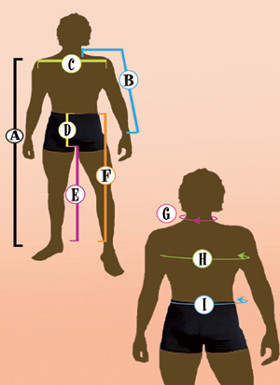Vintage clothing fit is best determined by your measurements, so grab a tape measure!
Taking your measurements:
Using a measuring tape, carefully measure yourself, wearing your undergarments. You may need a friend to help with measuring yourself, as it can be tricky to both hold and read the measuring tape! Not all of these measurements will be relevant to every garment we sell, but it's a good idea to take as many measurements as possible to ensure proper fit.
Our measurements reflect the approximate size (in inches) that you may be in order to wear our clothes comfortably. In other words, if we describe a dress as fitting approximately a 36-inch bust, that means you measure 36 inches around the bust (or less), including your chosen undergarments. Such a a garment may have a FLAT measurement of 38 inches, for example, but it should FIT a 36-inch bust with room to move--and breathe! (Outerwear items, like coats, are sized to fit over your clothing, so you would measure yourself with clothing on, in this case.)
We often provide the flat measurements as well as the approximate body size in inches. You can compare flat measurements to an item of clothing that fits you well, in order to help determine the fit. If you have any questions about measuring, or have special concerns about fit in certain areas, please contact us we will be happy to explain or provide more measurements for any of our vintage items.
Please email any questions to: info@vivavintageclothing.com
How our measurements are taken--so you know WHERE to measure:
Women's Measurements:
A. Total Length: measure from shoulder to hem
B. Underarm to waist: measure from under your arm to the narrowest part of your (natural) waist (especially useful for dresses with structured waists)
C. Out-seam length: measure from waist to hem (usually for pants/jeans, or skirt length)
D. Shoulder width: measure the back of a garment that fits you well, from shoulder seam to shoulder seam
E. Sleeve length: measure from the shoulder seam (or where shoulder seam would start if none) to the wrist
F. Rise: measure from the waist to the crotch seam (usually for pants/jeans--gives an idea of how high or low-waisted pants are)
G. Inseam length: measure from the inside of the crotch to the hem (for pants/jeans)
H. Neck: measure around the neck--not too tightly!
I. Upper arm: measure around bicep/widest part of upper arm
J. Bust: measure around fullest part of bust (bust size is not the same as bra size)
K. Ribcage: measure around the ribcage, below the bust and above the waist
L. Waist: measure around the natural waist, usually the narrowest part of the torso
M. Hip: measure around the fullest part of the hips, usually about 8 inches below the natural waist (this depends on your height)

Men's Measurements
A. Total length: measure from shoulder to hem
B. Sleeve length: for men's sleeve length, measure from the center back of collar to the sleeve hem
C. Shoulder width: measure the back of a garment that fits you well, from shoulder seam to shoulder seam
D. Rise: measure from the waist to the crotch (usually for pants/jeans--gives an idea of how high or low-waisted pants are)
E. Inseam length: measure from the inside of the crotch to the hem (for pants/jeans)
F. Out-seam length: measure from waist to hem (usually for pants/jeans)
G. Neck: measure around the neck--not too tightly!
H. Chest: measure under arms, around the chest
I. Waist: measure around natural waist--not too low!
